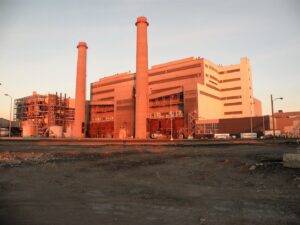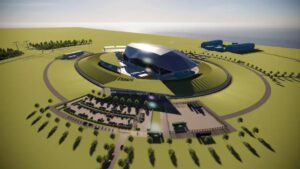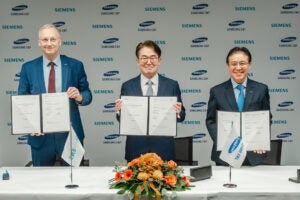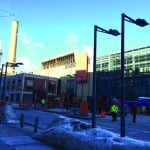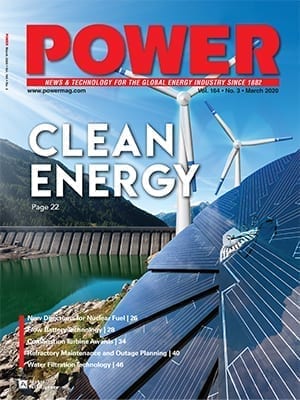District energy systems can accelerate decarbonization of buildings in cities.
The clock is ticking for building owners in U.S. cities that have enacted performance standards to reduce greenhouse gas emissions. The carrots and sticks of local energy codes to tackle climate change are quickly becoming mostly sticks.
With compliance deadlines looming, many owners of large buildings believe they have only undesirable choices: expensive heating, ventilation, and air conditioning (HVAC) renovations that disrupt the lives of occupants or formidable non-compliance fines. In Boston, for example, buildings over 35,000 square feet stand to face penalties of $1,000 per day beginning this year for failing to comply with the city’s Building Emissions Reduction and Disclosure Ordinance (BERDO).
But there is another way to avoid fines and disruption that has been proven over many decades and today is being used in cities around the world, including nearly 900 sites across North America. One of the first environmental strategies to clean up urban air quality and reduce emissions, district energy systems are also gaining new recognition as a way to decarbonize multiple buildings at a time, with lower exposure to capital costs and physical disruption of major building retrofits, and reduced operational risks.
Today’s district energy systems are clearly cleaner and more sophisticated than those deployed at the turn of the century, but they operate under the same simple principles underlying early systems. Thermal energy in the form of steam, hot water, and/or chilled water is recovered or produced at a central plant and is delivered to multiple connected buildings through an underground network of insulated pipes to be used for space heating, air conditioning, or domestic hot water.
This simplicity makes district energy an increasingly attractive way for building owners to comply with new emissions or energy code compliance requirements in cities. Based on building size, with fines for non-compliance, these performance standards now apply to 25% of U.S. buildings in 13 states, and 30 more states are expected to enact the requirements by 2026.
Very often, if the network is nearby, connecting to an existing district energy network in a city is a straightforward solution for buildings with hydronic heating and chilled water systems. In contrast, electrification, another way building owners commonly meet performance standards, can mean extensive in-building or utility infrastructure upgrades. Typically, electrification can also involve extensive utility upgrades to underground vaults, transformers, and potentially nearby substations, which can prove prohibitive, particularly in dense urban settings. Depending on the age and configuration of the existing building HVAC systems, shifting to electrified heat can involve extensive and invasive interior demolition and construction retrofits.
Undertaking such retrofits is difficult in occupied buildings, especially when gutting all or part of the structure. Deep retrofits—renovations that achieve significant greenhouse gas reductions—are particularly daunting, according to the Building Energy Exchange, which studied the process in 14 high-rise buildings. Among its findings:
- Deep retrofits tend to be invasive and require major system replacements, which are very challenging to do in an occupied building but may work in adaptive re-use.
- Electrification is key to deep decarbonization, but the economics and uncertainty of electrification needs to evolve before we are likely to see conversions at scale.
- The cost of natural gas relative to electricity often undercuts economic arguments for full building electrification as a standalone measure and code compliance costs may not fully overcome the cost differentials.
On the other hand, buildings connected to a district thermal energy network can often achieve emissions reductions without significant interior renovations. Decarbonization of supply occurs at the central plant and connected users capture the downstream benefits of the low- or no-carbon thermal supply. Modernizing and decarbonizing the central plant can be done with economies of scale. As a result, connected buildings can decarbonize more quickly and cost-effectively with little or no disruptive work within the building. The building owner is spared the capital cost and risks of a major retrofit and has access to more predictable operating expenses.
While district energy systems have provided reliable and resilient energy services for more than a century, they have evolved—and continue to evolve—to leverage advanced technologies to meet emerging and more stringent environmental requirements over time. Today, district energy systems often integrate multiple and redundant resources to ensure 99.999% customer availability while leveraging optionality to buffer seasonal pricing swings and mitigate grid interruptions from severe weather events.
“Many of these systems started out in the early 1900s using coal. They migrated from coal to gasified coal to oil. In the 1970s, with the oil embargo, they shifted to natural gas. So, the systems are constantly updated, and that’s a real strength and a real benefit for buildings connected to the system. Building owners don’t have to take on the risk of putting something in their basement that is going to be outdated or even outlawed within the next five or 10 years,” said Kevin Hagerty, CEO of Vicinity Energy. “The adaptability of district energy is a Monday for us; it’s something we do on a regular basis.”
Here’s how district energy systems in three major cities are pursuing innovations that prepare their customers to meet some of the stiffest building performance standards in the nation.
San Francisco, California
San Francisco passed the All-Electric New Construction Ordinance in 2020, which bans natural gas in new buildings. Many building owners see electrification as the likely alternative.
However, it’s difficult for buildings in the city to secure the volume of electricity required at a reasonable cost. Transmission and distribution constraints limit the movement of additional power into the city, and because of its scarcity, electricity costs are high. According to the Bureau of Labor Statistics, San Francisco’s electricity costs were 110% higher than the national average in November 2024. Analysts expect electricity rates to continue rising as demand grows due to electrification, artificial intelligence (AI), and data center energy consumption. Additionally, increasing electric capacity with new infrastructure, cabling, and substations in a dense urban underground can be very difficult and expensive.
Cordia offers a better alternative for the 185 buildings (and growing) served by its district energy system in downtown San Francisco. The company is installing an electric boiler to be supplied by renewable power from the nearby Hetch Hetchy hydroelectric station. Because the district energy system aggregates the heating needs of nearly 200 buildings in two square miles in a dense urban area, Cordia achieved economies of scale to negotiate a long-term power purchase agreement with favorable and stable terms.
The hydroelectricity will displace natural gas, which now fuels the system’s baseload thermal profile. During periods of peak energy demand, when the system needs more power than the hydro contract accommodates, Cordia plans to deploy a combination of peak load shedding, renewable natural gas, and battery storage to meet the extra demand.
“The project itself is pretty straightforward. We bring clean renewable power to our plant. We put electric boilers in our plant. We distribute carbon-free steam. Done. We can effectively decarbonize up to 250 buildings with this one project, as opposed to each one having to do its own electrical upgrade and gutting the entire building,” said Michael Eurkus, general manager for Cordia Energy.
Manhattan, New York
New York utility Con Edison operates the U.S.’s largest district energy steam system, which serves about 1,500 customers in Manhattan. It is currently the lowest-emissions energy source in the city because it uses natural gas to simultaneously produce both power and heat, making it cleaner than the combination of fuels used to generate grid power and heat as separate systems.
However, Con Edison is moving to further decarbonize its district energy system to help customers avoid the financial impacts of New York’s Local Law 97 (LL97). LL97 requires that 50,000 of the city’s largest buildings reach carbon neutrality by 2050 under a phased approach. Of those, 34,000 buildings became subject to emissions limits in 2024.
In 2024, Con Edison undertook an eight-month decarbonization study to assess the optimal mix of generating assets to most cost-effectively comply with New York State’s Climate and Community Leaders Protection Act. The study assessed 20 technologies on various criteria, which included technical, regulatory, and system factors, and ranked them. The highest-ranked technologies then moved into the various system modeling phases, the most granular being an hourly dispatch model. The research concluded that between now and 2035, electrification of the existing steam system offered the lowest levelized cost of energy for all concerned. After 2035, it’s less clear, so the utility is staying flexible and recalibrating as needed. This is a very important option to building owners in a dense urban setting like Manhattan, the city that never sleeps. Pending approval by the New York Public Service Commission, Con Edison plans to further decarbonize its system by deploying:
- Thermal energy storage.
- An electric boiler.
- An industrial heat pump at the East River Station.
Con Edison also began a study of district hot water systems last year in two areas of its service territory that appear suitable for district energy. That study is ongoing.
“Our existing district energy customers are very excited to hear that we’ve embarked on this study and we’re very anxious to hear the result of the study. They definitely want action—sooner rather than later,” said Joanna Yager, general manager of Con Edison’s district energy systems.
Boston, Massachusetts
The City of Boston passed the first iteration of BERDO in 2019, a law mandating large buildings to benchmark their water and energy use, and undergo verification audits. That was a precursor to BERDO 2.0 in 2021, which took the next step. BERDO 2.0 requires that buildings meet carbon emissions standards beginning in 2025, which become more stringent over time, leading to net zero emissions by 2050.
Vicinity Energy serves 245 buildings—71,400,000 square feet—in Boston and Cambridge. It is readying its system for the city’s 2050 goal by replacing fossil fuel generation with renewable electricity. This will allow its customers to achieve building performance standards without having to substantially renovate or reconfigure the HVAC systems in their buildings.
In November 2024, the company began operating a 42-MW industrial-scale electric boiler at its Kendall plant in Cambridge, Massachusetts, completing the project from concept to commissioning in only 24 months. Historically, the Kendall Station operated as a combined heat and power (CHP) facility, generating electricity to sell power into the grid and produce steam for distribution to hundreds of connected buildings in Cambridge and Boston. The plant connects to the regional power grid at a wholesale level. This single electric boiler has the capacity to serve nearly 30 million square feet of connected customer space, clearly providing a low-carbon solution at scale.
Before deciding to electrify, Vicinity considered a range of alternative fuels for its system, including biogenic fuel, renewable natural gas, and hydrogen. Hagerty said that Vicinity settled on electricity because it offers the most flexibility. The regional electricity grid is supplied from a range of clean resources—nuclear, wind, hydroelectricity, and solar—providing more visibility on the carbon intensity of power supplies.
Vicinity has contracted for a mix of renewable energy from ISO New England. Because the district energy system aggregates multiple customers and is connected to the grid at the transmission level, it can purchase power at wholesale rates, which sometimes costs half that of retail energy, creating additional advantages for customers. In addition, the company is positioning to procure power directly from an offshore wind farm.
Vicinity’s electric boiler can also react quickly to price signals and turn on or off swiftly to take advantage of grid power pricing variations or a rapid increase in steam demand from buildings on cold days. The next phase to decarbonize the district steam system will involve integration of industrial, high-temperature heat pumps using water from the Charles River.
Vicinity operates 19 district energy systems in 12 cities, but the Kendall plant provides the most sophisticated approach to decarbonization, which Hagerty attributes to BERDO 2.0. Most other cities where Vicinity operates are also moving toward adopting some form of building performance standards.
“This project is a terrific example of the leadership and vision of businesses seizing the opportunities of the clean energy transition,” said Brad Campbell, president and CEO of the Conservation Law Foundation. “The commercial heating and power sector has long been considered ‘hard to decarbonize,’ but Vicinity is showing it can be done with existing technology in a competitive environment.”
Opportunities and Challenges
District energy is ideally suited for clusters of buildings in cities, communities, and campuses. By aggregating the heating and cooling needs of energy users situated near one another, district thermal energy networks can invest in highly efficient, industrial-grade technologies or lower- carbon solutions that may not be financially viable on an individual building basis. Creating or expanding a thermal energy network can also enable energy recovery and energy-sharing approaches, such as recovering heat from a nearby data center to supply contiguous customers. Over time, district thermal networks can be expanded and interconnected to scale up to a city-wide system, integrating and innovating to leverage a series of supply options.
The path ahead will require continued education to increase awareness of district energy systems as a near-term decarbonization option in cities. It will also be important for building owners to consider the ancillary advantages of district energy—benefits beyond price stability, carbon reduction, and avoiding costly renovations. For example, district energy can increase property values by enabling building owners to reclaim valuable roof and penthouse space for tenant amenities made available by removing onsite heating and cooling equipment.
As we all know, uncertainty can also slow decision-making. It’s not always easy for building owners to undertake an apples-and-oranges comparison between district energy service and electrification. It’s important to consider cost models for several years into the future. While district energy services are typically more predictable over time, electricity costs are likely to become even more volatile and uncertain due to demand growth, variations in weather patterns, changes in building code compliance requirements, and shifting market conditions in a post-pandemic economy. Today, downtown district energy systems in cities are likely to offer a safer “port in the storm” and are in prime position to accelerate decarbonization while lowering risk for building owners in cities.
—Rob Thornton is president and CEO of the International District Energy Association. Visit the International District Energy Association website for more information about district energy, including insight into best practices, technology options, and policy guidance.


